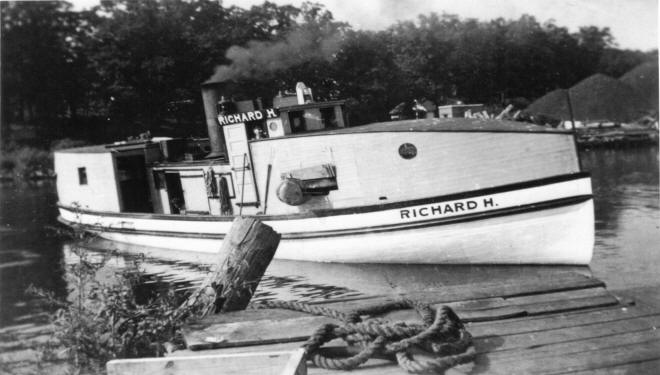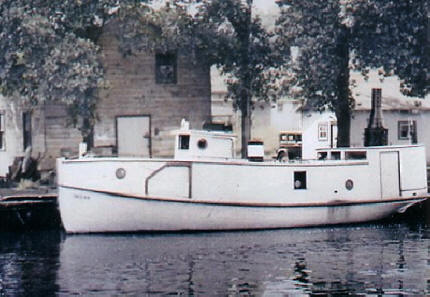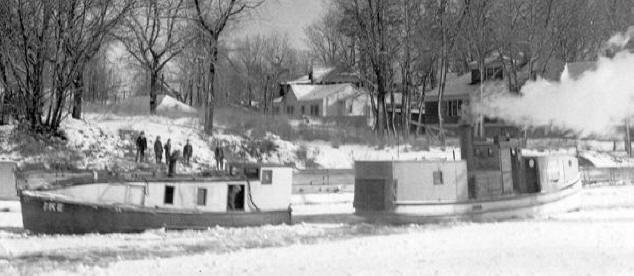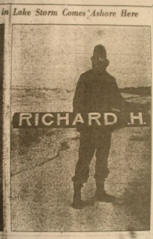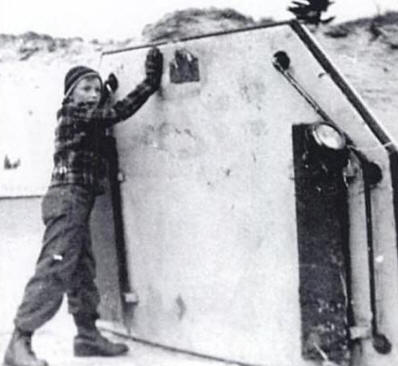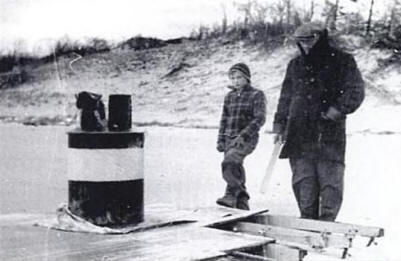The 19 ton fishing tug Richard H. was 43.8 feet in length with a beam of 12 feet. She was a steam powered vessel built at Marinette, WI in 1923. The fish tug was owned by William Prue of Green Bay, WI in 1938. Captain McKay, who purchased the Richard H. in 1939, said he had recently remodeled the upper structure of the boat. The superstructure had been cut down ten inches in the remodeling.
At the time of her loss, the Richard H. was owned by Captain John McKay, who originally hailed from Alpena, but had moved to South Haven with his family in the Spring of 1936. Capt. McKay was involved in the fishing industry, owning a number of tugs, as well as a laundry business. He had owned the Richard H. for about a year, having bought her in Green Bay, Wisconsin. Captain McKay was not on the tug at the time of her sinking, but was very active in search and recovery efforts. Capt. McKay lived at 109 Michigan Ave, in South Haven, MI.
McKay’s son, John McKay Jr. was 28 years old and the youngest member of the Richard H. crew. Born in Alpena, John Jr. worked for his father, driving a laundry truck and working the fishing boats. He had married his sweetheart, Blanche Maxwell, a former Chicagoan, in March, previous to his disappearance. They lived at 308 Eagle St also in South Haven.
Crewmember Stanley White, age 33, originally came from from Rhineland, Wisconsin. Stanley was an experienced fisherman and a seasoned sailor. His first voyage on the Richard H. also was his last.
The third Richard H. crewman, John Taylor, was 35 years old. He left behind a wife and two young boys. The family had lived in an apartment above the Royal Blue store for a year prior to his disappearance.
The fishing tug Indian was 26 gross tons and built in 1914 at Manitowoc, Wisconsin by the Burger Boat Company. The Indian was 40.1 feet long with a 12 foot beam. Powered by steam for many years, she was fitted with the latest Kahlenberg Oil Engine in 1936. At the time of her loss, the fish tug had recently been purchased by James Madsen of South Haven 1939.
The crew aboard the Indian that day were 55 year old James Madsen, 35 year old Harold Richter, 30 year old Bill Bird and Art Reeves
The first day of trout season in 1940 was Monday the 11th of November–Armistice Day. The Richard H. and another tug named the Indian left the harbor to set their nets for trout and whitefish. The Indian headed past the pier heads first at 7:35 am. The Richard H. headed out the of channel with its three man crew around 9:00 am. The boat usually had four crewman aboard, but the fourth fisherman failed to show up at the dock on time. Missing the boat gave that man a much longer life. Shortly after the Richard H. hit open water the Coast Guard issued storm warnings. Unfortunately the fish tugs had no way of receiving this information.
At approximately 1:30 pm, shortly before a terrific gale hit the area the Richard H. was sighted about five miles out. Soon after, the waters of the Lake Michigan were whipped in an inferno by a sustained 60-mile per hour gale which rolled up mountainous waves and spread a milky mist over the water. Visibility was blacked out. Occasionally, wind velocity reached 75 miles per hour. The worst part of the storm passed quickly.
At 2:50 pm, a United States Coast Guard powered lifeboat was launched to find the missing tugs. Shortly thereafter, contact was lost with the Coast Guard boat and she too was presumed lost.
With the Richard H. and the Indian gone from sight, speculation began on shore. The Indian was thought lost a year earlier in rough weather, but made port in Chicago after fighting the storm. Her diesel power plant and larger size gave her an advantage over the smaller Richard H. Many on shore thought the Indian would make port later, like she did the year before.
But the fate of the Richard H. worried people. The Richard H. was powered by steam, which is not as reliable as diesel and required much more attention to keep running in inclement weather. With the fish tugs and their only hope of rescue, the Coast Guard boat, missing, many South Haven families had a sleepless Monday night.
By Tuesday afternoon, hope for the survival of the three lost vessels was lost. The Coast Guard patrolled beaches between Benton Harbor and Holland with 4 mile intervals. The Church of the Epiphany at South Haven announced that requiem mass would be held for the 12 missing men Wednesday morning.
Portions of the wrecked hull of the Indian was located shortly before 6:00pm Tuesday, by a party of four Coast Guardsmen patrolling the beach between Grand Haven and Holland.
Wednesday brought grim news from the Grand Haven area. Wreckage from the Indian and the Richard H. was found North and South of the Grand River. The top of the pilot house and stack for the fish tug Indian came ashore about 400 yards South of the Tom Johnson cottage. A life jacket from the Richard H. was found along with the tug’s name board. The life jacket straps were broken.
The only good news of the day was the report that the Coast Guard power lifeboat and crew were safe in Chicago. They fought the weather 25 straight hours after leaving to search for the missing tugs. One of the crew claimed they encountered 40 foot waves in their journey across the lake. The boat made port in Chicago under its own power and the crew ate, slept, and got attention for minor injuries. The valiant crew received a well deserved hero’s welcome upon their return to South Haven.
The only body that was recovered and identified was that of John Taylor, Jr., machinist and engineer of the Richard H. His body was found at 9:00 am Saturday morning near an inlet a half mile South of the Grand Haven breakwater, where bits of wreckage of the two tugs were found. The body was first identified as that of Stanley White, but Chris Jensen, owner of the fish tug Ike, later identified it as that of Taylor. The body was fully clothed and strapped in a life preserver. Taylor’s three brothers arrived in Grand Haven late Saturday to complete the identification.
They removed a watch which was found to have stopped at seven minutes to three, which lent support to the theory that the Richard H. may have gone down in a futile fight with the terrific squall which hit the area at 1:10 pm Monday. The brothers said he usually wound the timepiece around 9:00 am. The watch was attached to a chain, its face yellowed by the water. Two other life preservers of the Richard H. were found, accounting for all three presumably used by the crew members.
None of the crew of the Richard H. carried life insurance. The Richard H. also carried no insurance, according to its owner, John McKay Sr.
Information for the above article was gleaned from the South Haven Tribune, the Grand Haven Tribune and Kit Lane’s:”Lake Michigan Shipwrecks: South Haven to Grand Haven.”
Richard H and Ike image courtesy of the Marialyce Canonie Great Lakes Research Library,Michigan Maritime Museum, South Haven, Michigan.


